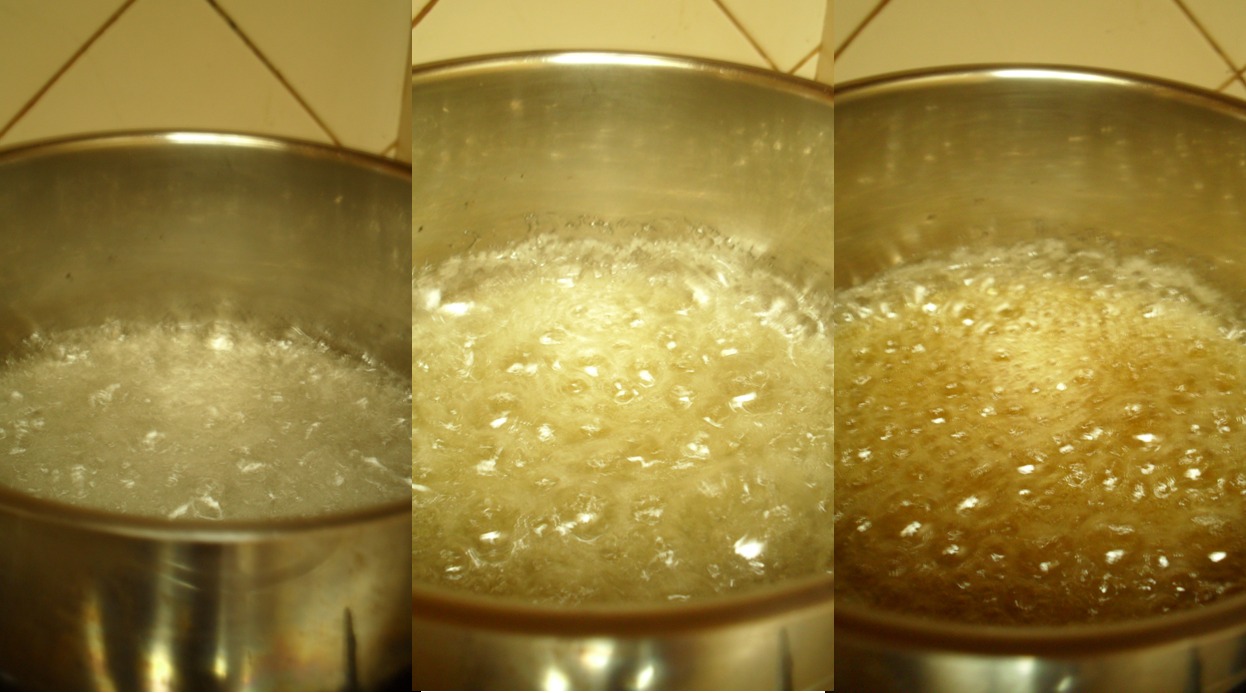Creamy chocolate fudge…soft caramels…and hard brittle toffee all have something in common. They all have to be cooked to the correct temperature to reach the consistency typical of each candy.
Do you want to know thhe most important secret to making delicious candy? Follow the recipe and accurately measure the ingredients and temperatures during the cooking process.
Hard-crack stage (300 degrees Fahrenheit and above): A small amount of syrup added to cold water makes a loud cracking noise and separates into brittle threads. The hard-crack stage is for toffee and hard candies like lollipops. Above 330 degrees Fahrenheit, the sugar begins to caramelize and brown.

5 Tips for Successful Candy Making
- Measure all the candy recipe ingredients accurately. Use a kitchen scale if you have one to ensure exact amounts.
- If you use a candy thermometer, either clamp the candy thermometer to the side of the pan or periodically place it into the syrup to measure the temperature. The bulb at the bottom of the thermometer should not touch the side or bottom of the pan. If it does, temperatures will be inaccurate. Read the temperature on the thermometer at eye level. Try not to tip the pan to get a readingt–this will lead to cooler than actual temperatures.
- Cook the candy precisely to the temperature or “stage” listed in the recipe. For example, when making Aunt Emilys Soft Caramels the recipe directs to cook the candy mixture to 244°F, or firm ball stage on a candy thermometer. When the candy has reached the correct temperature, remove the thermometer and cool it before washing; otherwise it may break.

- If you do not have a candy thermometer use the cold water test to determine if the candy mixture has reached the proper consistency for doneness. Here are the steps to tell the temperature without a candy thermometer:

- Drop a small amount of the candy mixture with a teaspoon into a small bowl of cold water. Each time you test the candy use a fresh bowl of cold water.
- If the candy forms a thin thread and does not “ball up”, it is in the thread stage or 230°—235°F. This stage is similar to sugar syrup rather than candy.
- If the candy forms a soft pliable ball, it is in the softball stage, about 235°— 240°F. This is the stage you would cook to if you are making fudge.
- If the candy forms a firm but not hard ball, it is in the firm ball stage. The temperature of this stage is between 242—248°F. Caramels are cooked to the firm ball stage.
- If the candy forms thick threads when it drips from the spoon, it is in the hard ball stage or 250°—265°F. If you gather the candy mixture into a ball it will be a hard ball. Divinity or rock candy is typically cooked to this stage.
- If the candy forms flexible, but not brittle threads after dropping a small amount into cold water, the candy is at the soft crack stage or 270°—290°F. Cook candies such as butterscotch to this temperature.
- Finally, if the candy forms hard, brittle strands that easily break, the candy is at the hard crack stage, between 300°—310°F. Butter toffee and peanut brittle are examples of candies cooked to this temperature.
- Before making your candy, test the thermometer’s accuracy by testing it in a pan of boiling water. At sea level the thermometer should read 212°F. If the thermometer reads above or below this number you will need to make the necessary adjustments when making your candy.
Check out our holiday candy collection for great gift ideas. The variety of candy recipes is endless, but this is a great place to start for finding new treats to make. Youll have success making candy from fudge to toffee if you follow our tips!
Did you find this article helpful? Has it inspired you? What else would you like to know?
Ready to make the recipe? Let’s get started making Aunt Emilys Soft Caramels!
Candy Science – Boiling Sugar
FAQ
How to tell if candy is at hard crack stage without thermometer?
What temp does toffee crack?
How long does it take for hard candy to reach 300 degrees?
How do you know when toffee is done?
What temperature does candy hard crack take shape?
The candy hard crack stage takes shape around 300 degrees Fahrenheit (149 degrees Celcius). You can make hard candies like lollipops and brittle once you reach the hard crack stage.
What temperature does a candy soft crack stage start?
The candy soft crack stage begins at 270 degrees Fahrenheit (132 degrees Celsius). The soft crack stage is perfect for making delicious butterscotch, taffy, and candy apples.
What is the earliest candy temperature stage?
The earliest candy temperature stage is the thread stage. At this temperature, the syrup drips from a spoon and forms thin threads in cold water. Syrup at the thread stage is perfect for candied fruits. Continue to 4 of 9 below. The syrup easily forms a ball while in the cold water but flattens once removed from the water.
How do you know if a candy is hard-crack?
Only seasoned candy makers memorize temperatures since most candy thermometers will display both temperature and stage. Hard-crack stage occurs at 300 to 310 F. If you don’t have a candy thermometer, you can use the cold water test in a pinch: Drop a spoonful of hot syrup into cold water, then remove the candy from the water and attempt to bend it.
